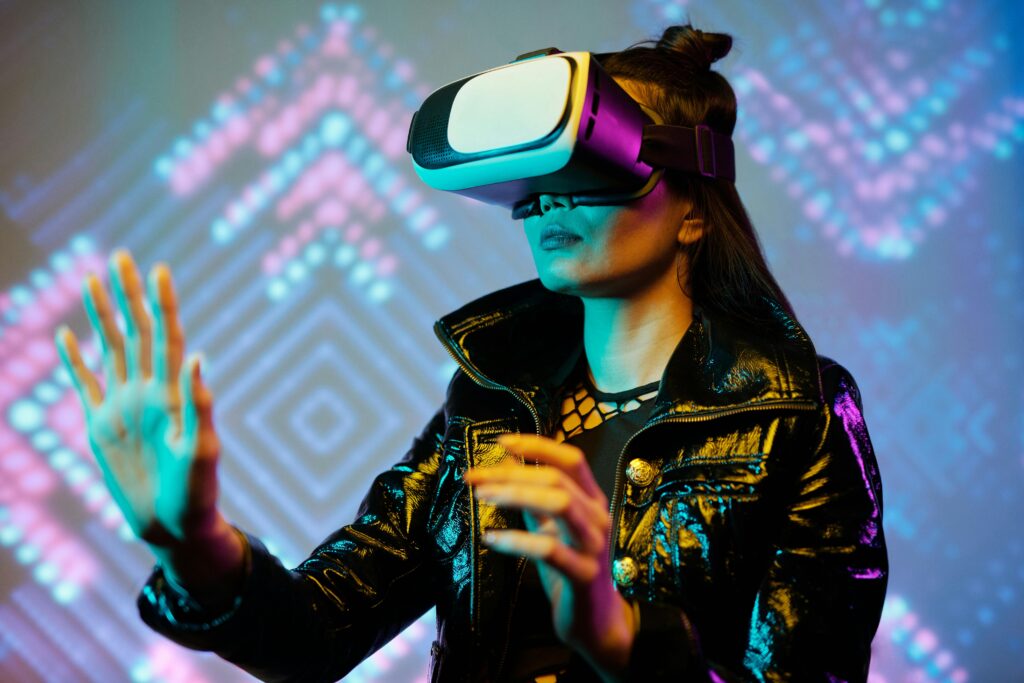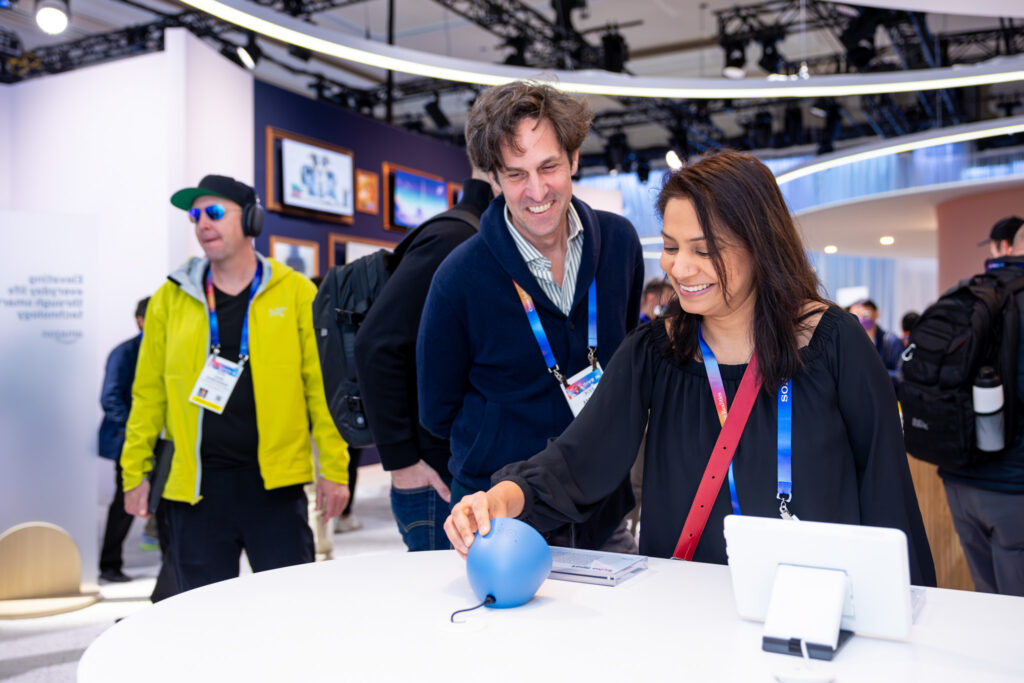SXSW is known mainly as a tech/music/film festival. But more and more, healthcare is becoming a defining presence. This year, the Health and MedTech Track featured content on how technology and social changes are impacting one of the world’s largest industries. Technology is transforming the way healthcare is delivered, whether through AI, telemedicine, and/or treatment—and clashing directly with patient access problems, cost concerns, and trust issues. If you are an event marketer in the healthcare or pharma industry, don’t miss out on the strategic insights we share throughout this article and how you can leverage atypical events to drive brand awareness and exposure.
Where we are (cough*not great*cough)
Historically, healthcare has been driven by population-level data and treatment algorithms informed by cost. Add to this the results of a recent Gallup poll showing 52% of Americans rate the healthcare system as ‘fair’ or ‘poor’ and a dismally low trust score of 18% based on the Global Trust Index, and you can see why healthcare in general—and the pharmaceutical industry specifically—needs to do some reputation repair.
"Trust in organized institutions has been declining for years and health care is not immune. Building trust requires engaging stakeholders across the health care spectrum to better identify what’s happening and share practices that increase trust between different parties. Trust is an essential part of medical professionalism and ultimately contributes to better patient outcomes.”
-Daniel Wolfson, EVP/COO of the ABIM Foundation
Source: ABIM Foundation
Positioning an organization as authentic, genuine, and honest in an environment where your target audience is skeptical, concerned about data breaches, and outraged about the cost of treatment is difficult. Refreshingly, SXSW showcased a solid series of talks to educate, enlighten, and encourage better engagements between healthcare systems, patients, and HCPs.
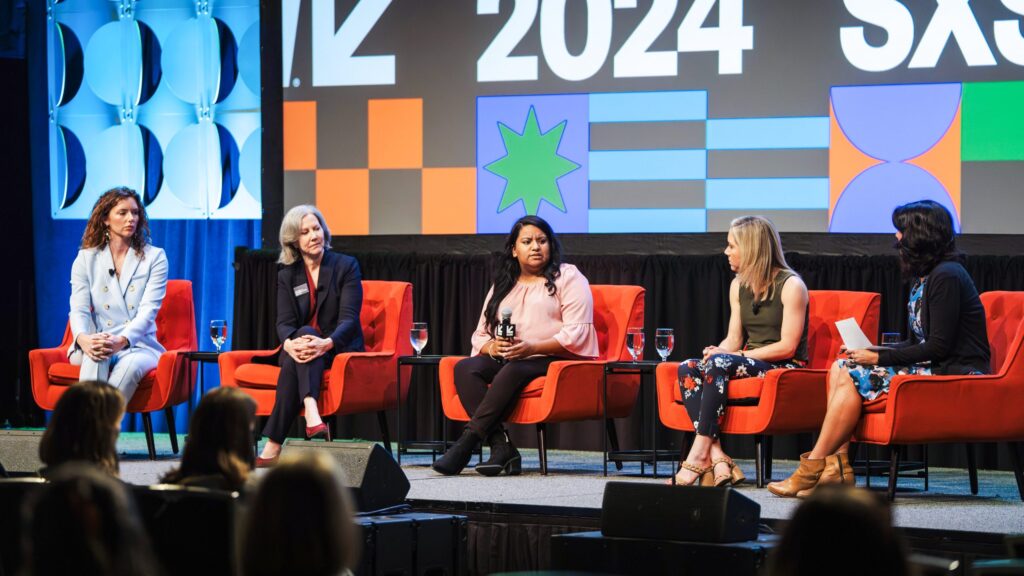
We’re on the road to wellbeing
“SXSW provides us an opportunity to discuss how technological and social changes are reshaping healthcare right now, in real-time.”
-Vanessa Broadhurst, EVP of global corporate affairs, J&J
Like other industries before them, healthcare is discovering that their users are more engaged, proactive, and demanding than ever. Traditionally, healthcare consumers went to the doctor when they were sick and received treatment for that specific illness in that specific timeframe. Now, healthcare consumers and their insurance providers are more likely to want a proactive approach to managing health.
Many insurers today are covering weight loss programs, exercise memberships, and healthy nutrition plans because they’re cheaper than treating diseases like diabetes and hypertension. Additionally, wearable technology allows people to know the status of everything from their sleep cycle to their heart rate with a single touch.
Consumers want personalized healthcare experiences that are relevant to them and—most importantly—are focused on wellness, rather than sickness. Being well and staying well is considered an essential component of healthcare interaction, whether it be in-person, through an app, or via telemedicine. At the same time, healthcare consumers and HCPs want to know the data they provide is secure, the data they use to inform decisions is accurate, and that they are being given access to all the options they need to pursue treatment plans efficiently and effectively.
And pharma? They’ve intuited that funding actionable, relatable and humanistic interactions and tech options can help build trust and overcome the ‘just in it for the money’ perception.
For example, J&J has its second year as a SXSW headlining sponsor under its belt, expanding its presence to include an interactive healthcare lounge featuring immersive experiences “at the intersection of cutting-edge technology and human empathy”, as well as pitch and networking events, and hosting 6 different healthcare panels. And they’re not the only ones. Multiple pharmaceutical companies, healthcare tech companies, and other health-related organizations were there, highlighting the increased importance of health and wellness in a rapidly shifting healthcare environment.
However, from an event marketer perspective, we observed that many of these companies were still very tucked away from the main thoroughfare which meant that attendees needed to seek these spaces out rather than discover the experience in transit. This would suggest that having some events or spaces located more on the streets or main buildings would deliver better organic traffic and brand awareness at the event.
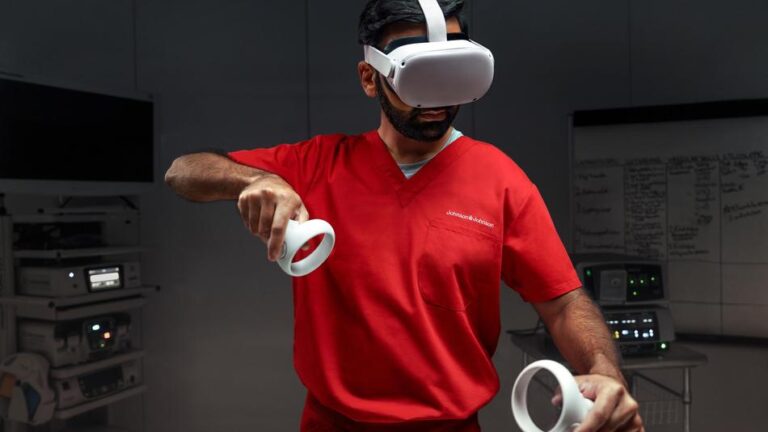
Data (in)security
While many people are comfortable with health data on their smart watch or other wearable, they balk at providing personal health data through online portals and electronic medical records (EMRs). And with good reason. In 2023 alone, 725 large security breaches in healthcare were reported, with healthcare data from nearly 134 million people hacked.
The SXSW Health and MedTech track focused on data security, but also on how we use the data collected to create a better healthcare experience in the future.
Right now, the wearables and online tools and apps we use are siloed and disconnected, leaving us with no lack of data, but rather considerable knowledge and communication gaps that impact how we can improve outcomes. There’s also that fundamental mistrust in the healthcare industry we mentioned earlier, with some feeling like they’re facing ‘genetic punishment’ from insurance and other healthcare-related organizations for things beyond their control by providing their healthcare data.
Bolstering confidence in data security, linking health tech data, and rebuilding trust in the healthcare industry will increase the likelihood of people sharing their health data with the tech platforms that can then build the seamless, highly personalized, and relevant experience people are seeking in ways that retain privacy and minimize negative repercussions of information sharing. Imagine the possibilities of leveraging standardized and secure wearable health data with in-event engagements that deliver fully personalized experiences to participants! So, how do pharma and healthcare companies use events to establish trust that will encourage sharing and participation with attendees?
All in on AI
AI was top of mind everywhere, and the healthcare track was no exception. The main takeaway here is that there is a transformation turning healthcare workers into tech workers, and that hiring, and skillset alignment will be key to success. In fact, BMS was the only Pharma company there to have an exhibit booth in the main expo hall and their primary purpose was recruiting talent. This was a genius strategy as it is unlikely the majority of qualified SXSW attendees for BMS careers would have previously considered a role in, or interacted directly with, a pharmaceutical company.
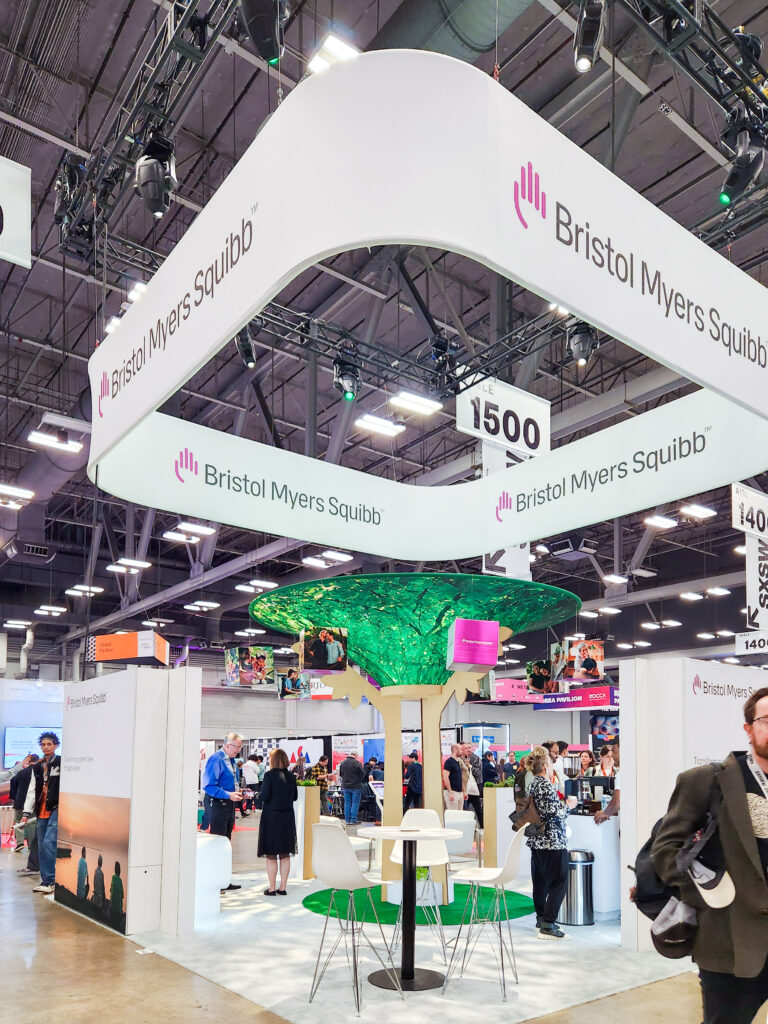
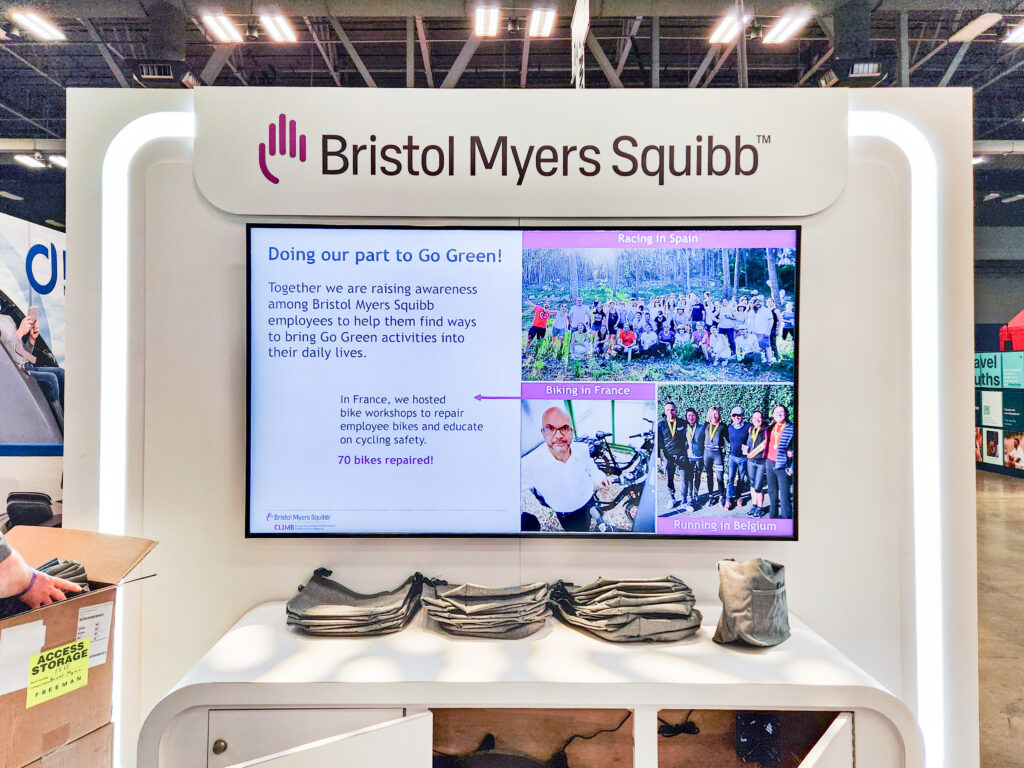
AI and other emerging technology are increasingly being used to lower care burdens for HCPs. Everything from appointment scheduling and follow-up, to record-keeping, to diagnoses and surgical technique training is in play. The overarching goal is to free HCPs from mundane, repetitive tasks and allow them the time to really hone their skillsets and connect with their patients.
The use of AI is also designed to decrease HCP burnout, fatigue, and errors. AI and machine learning are also being used to cull mountains of published data down to the most relevant articles for research, improve patient communication via instant translation, and reduce the risk of error through thorough note-taking and data entry. Importantly, the recurrent theme throughout SXSW was that AI is a tool for humans to use, not a tech takeover.
For example, using AI to reduce workload may help improve HCP-patient conversations and lead to more productive appointments. So how do you bring this into an event to build trust and consumer buy in? We suggest through demonstrations such as showing two timed scenarios in the booth where one procedure is done manually and one by the AI offering.
Health equity
The idea of furthering health equity through technology is simple: where you live should not determine if you live. AI and machine learning has the potential to increase access to medical knowledge in areas that lack actual in-person offices, as well as improving diversity in clinical trial enrollment. A panel session held at SXSW 2024 was devoted to exactly that, while others focused on how technology could help bridge the gap between people and practitioners at every touchpoint during drug development and commercialization. While diversity was often framed in racial or ethnic terms, it was understood that diversity is a conglomerate of lived experiences from where we live, which often determines our access to quality healthcare, healthy foods and scientific education.
At SXSW, discussions around built-in tech bias, AI monitoring, and access to technology were all framed by inclusion and equity concerns as to how these advances could be utilized fairly regardless of income, geographic location, health literacy, and access. Use smaller scale, community events to meet patients and caregivers where they already are to build relationships and trust.
“I think technology is wonderful, but it can either open the gap and make it larger, or technology can close the gap. When it comes to AI or machine learning, there’s bias in these models. How do we mitigate bias, so we can promote health equity?”
-from the MedTech SWSW session “Tech’s role in equity and value-based care.”
Rebranding cancer
In just a few short decades, a cancer diagnosis has gone from a death sentence to a condition that many people live with for years. According to the SXSW session entitled “Rebranding Cancer”, 50% of those diagnosed will live 10+ years with cancer. That’s why the cancer community is moving away from stigma and sadness to hope and optimism.
The intent of this session—and of many others—was to feature the technology and innovations that has made progress possible thus far, and to explore the promise of new advances on the horizon.
The SXSW Health and MedTech Track included other disease categories such as mental health and rare disease, but the majority of sessions focused on cancer. As the largest disease-specific topic in the track, sessions ran the gamut from “Disrupting Cancer Care” to a “Cancer Health Equity Meetup”—each one highlighting the positive breakthroughs that truly make a difference for patients now, as well as for the future.
How can insightful and powerful sessions like these extend into events beyond SXSW? It would be great to see adoption of these themes, panel approaches, and more candid conversations at congresses like the American Society for Clinical Oncology (ASCO) Annual Meeting – the most significant gathering of oncology professionals worldwide.
Working together to go beyond the typical
In conclusion, healthcare presence at SXSW is expanding almost as rapidly as technology. The Health and MedTech Track was a tapestry of different perspectives, technology discussions, thoughtful conversations, and powerful reminders that health care—not sick care—requires pharmaceutical companies, healthcare systems, technology organizations and consumer groups to work together to further the goal of improving patient outcomes.
Meeting patients where they are in terms of access, technologic savvy, scientific literacy, and geographic location is key to increasing the trust and confidence that drive better, more customized experiences. As data and tech become more interwoven with advocacy and patient insights, look for a paradigm shift in how healthcare information is gathered, consolidated, and disseminated in ways designed to optimize access and increase health equity and inclusion for everyone.
As we hope is evident from this article, we, as event marketers, should be looking beyond the typical congress program for experiential opportunities to engage with other stakeholders (patients, caregivers, and advocates). A few questions arise that we propose for your consideration embarking on this endeavor:
- Where are my patients, their caregivers, and advocates already?
- What are their top unmet needs or barriers?
- What type of event can we initiate and or join to enable a dialogue the drives a positive impact on our relationships with these populations? How will we follow up and follow through on our progress from the event after it so that it is not limited to a moment in time?
To learn more about other key themes at SXSW 2024, check out our full report here.
By: Leah Cepko and Jolanta Schwartz





